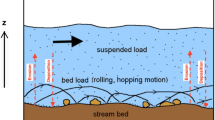Abstract
Nested circulation models developed to date either exclude the flooding and drying process or prohibit flooding and drying of nested boundaries; they are therefore ill-suited to the accurate modelling of inter-tidal areas. The authors have developed a nested model with moving boundaries which permits flooding and drying of both the interior domain and the nested boundaries. The model uses a novel approach to boundary formulation; ghost cells are incorporated adjacent to the nested boundary cells so that the nested boundaries operate as internal boundaries. When combined with a tailored adaptive interpolation technique, the approach facilitates a dynamic internal boundary. Details of model development are presented with particular emphasis on the treatment of the nested boundary. Results are presented for Cork Harbour, a natural coastal system with an extensive inter-tidal zone and a complex flow regime which provided a rigorous test of model performance. The nested model was found to achieve the accuracy of a high resolution single grid model for a much lower computational cost.





















Similar content being viewed by others
References
Alapaty K, Mathur R, Odman T (1998) Intercomparison of spatial interpolation schemes for use in nested grid models. Mon Weather Rev 126:243–249
Barth A, Alvera-Azcárate A, Rixen M, Beckers J-M (2005) Two-way nested model of mesoscale circulation features in the Ligurian Sea. Prog Oceanogr 66:171–189
Blayo E, Debreu L (1999) Adaptive mesh refinement for finite-difference ocean models: first experiments. J Phys Oceanogr 29:1239–1250
Blayo E, Debreu L (2005) Revisiting open boundary conditions from the point of view of characteristic variables. Ocean Model 9:231–252
Blayo E, Debreu L (2008) Two-way embedding algorithms: a review. Ocean Dyn 58:415–428
Clark TL, Farley RD (1984) Severe downslope windstorm calculations in two and three dimensions using anelastic interface grid nesting: a possible mechanism for gustiness. J Atmos Sci 41:329–350
Costello MJ, Hartnett M, Mills P, O’Mongain E, Collier L, Johnson M, Nash S, Leslie R, Berry A, Emblow C, Collins A, McCrea M (2001) Nutrient dynamics of two estuaries in Ireland: Wexford and Cork Harbours, Irish Environmental Protection Agency
DHI Software (2007) Mike 21 flow model: hydrodynamic module user guide, DHI Water and Environment
Falconer RA (1984) A mathematical model study of the flushing characteristics of a shallow tidal bay. Proc Inst Civil Eng 2 Res and Theory 77(3):311–332
Falconer RA, Chen YP (1991) An improved representation of flooding and drying and wind stress effects in a 2-D tidal numerical model. Proc Inst Civil Eng 2 Res and Theory 91:659–678
Fox AD, Maskell SJ (1995) Two-way interactive nesting of primitive equation ocean models with topography. J Phys Oceanogr 25:2977–2996
Ginis I, Richardson RA, Rothstein LM (1998) Design of a multiply nested primitive equation ocean model. Mon Weather Rev 126:1054–1079
Holt J, Harle K, Proctor R, Michel S, Ashworth M, Batstone C, Allen I, Holmes R, Smyth T, Haines K, Bretherton D, Smith G (2009) Modelling the global coastal ocean. Philos Trans R Soc A 367:939–951
Koch SE, McQueen JT (1987) A survey of nested grid techniques and their potential for use within the MASS weather prediction model, NASA Technical Memorandum 87808, National Aeronautics and Space Administration, USA
Korres G, Lascaratos A (2003) A one-way nested eddy resolving model of the Aegean and Levantine Basins: implementation and climatological runs. Ann Geophys 21:205–220
Leitão P, Coelho H, Santosa A, Nevesa R (2005) Modelling the main features of the Algarve coastal circulation during July 2004: a downscaling approach. J Atmos Ocean Sci 10(4):421–462
Lin B, Falconer RA (1997) Tidal flow and transport modelling using the ULTIMATE QUICKEST scheme. J Hydraul Eng 123(4):303–314
Marchesiello P, McWilliams J, Shchepetkin A (2001) Open boundary conditions for long-term integration of regional oceanic models. Ocean Model 3:1–20
Miyakoda K, Rosati A (1977) One-way nested grid models: the interface conditions and the numerical accuracy. Mon Weather Rev 105:1092–1107
Nash S (2010) Development of an adaptive mesh inter-tidal circulation model, PhD Thesis, College of Engineering & Informatics, National University of Ireland Galway
Nittis K, Perivoliotis L, Korres G, Tziavos C, Thanos I (2006) Operational monitoring and forecasting for marine environmental applications in the Aegean Sea. Environ Modell Softw 21:243–257
Nycander J, Doos K (2003) Open boundary conditions for barotropic waves. J Geophys Res 108(C5):3168–3187
Palma ED, Matano RP (1998) On the implementation of passive open boundary conditions for a general circulation model: the barotropic mode. J Geophys Res 103(C1):1319–1341
Pullen J, Allen JS (2001) Modeling studies of the coastal circulation off the northern coast of California: statistics and patterns of wintertime flow. J Geophys Res 106(C11):26959–26984
Roed LP, Cooper C (1987) A study of various open boundary conditions for wind-forced barotropic numerical ocean models. In: Nihoul JCJ, Jamart BN (eds) Three-dimensional models of marine and estuarine dynamics. Elsevier, pp 305–335
Rowley C, Ginis I (1999) Implementation of a mesh movement scheme in a multiply nested ocean model and its application to air -sea interaction studies. Mon Weather Rev 127:1879–1896
Spall MA, Holland WR (1991) A nested primitive equation model for oceanic applications. J Phys Oceanogr 21:205–220
Spall MA, Robinson AR (1989) A new hybrid coordinate open ocean primitive equation model. Math Comput Simul 31:241–269
Staneva J, Stanev EV, Wolff JO, Badewien TH, Reuter R, Flemming B, Bartholoma A, Boldinge K (2009) Hydroynamics and sediment dynamics in the German Bight: a focus on observations and numerical modelling in the East Frisian Wadden Sea. Cont Shelf Res 29:302–319
Zhang D-L, Chang H-R, Seaman NL, Wamer TT, Fritsch JM (1986) A two-way interactive nesting procedure with variable terrain resolution. In: Koch SE, McQueen JT (1987)
Acknowledgment
The authors would like to acknowledge financial support from INTERREG IV -Atlantic Area Programme under the Marine Renewable Energy (MAREN) project.
Author information
Authors and Affiliations
Corresponding author
Additional information
Responsible Editor: Eric Deleersnijder
Appendix A: spatial interpolation formulae
Appendix A: spatial interpolation formulae
1.1 Zeroth-order interpolation scheme
If ϕ i represents the value of a parent grid variable at cell i, then ϕ k for all the child grid cells within its confines can be written as:
where m is the number of child grid cells within the parent grid cell, i.e. \( m = r_s^2,{r_s} \) being the spatial nesting ratio.
1.2 Linear interpolation scheme
The variable ϕ in a child grid cell k which lies within the parent grid cell i may be calculated as:
with ω, the proportional interpolation coefficient, further expressed as:
1.3 Quadratic interpolation scheme
For a given nesting ratio r s , the interpolation of the parent grid cell variable ϕ i to any child grid cell k of any horizontal row of enclosed child grid cells may be specified as (adapted from Alapaty et al. (1998)):
with the function E further expressed as:
where λ represents a normalised local coordinate pointing in the same direction as the global coordinate and whose origin coincides with the centre of the parent grid cell i. The value of λ for the child grid cell k is defined as:
and
Δx p and Δx c are the parent and child grid spacings, respectively. The parameter α is introduced to ensure mass conservation following Clark and Farley (1984).
1.4 Inverse distance weighted interpolation scheme
The variable ϕ in a child grid cell k which lies within an enclosing parent grid cell is calculated as:
where n is the number of parent grid cells used in the interpolation and w i is the weighting function. For the nested model n = 9, i.e. the enclosing grid cell and the eight adjacent grid cells were used. The weighting function is written as:
where d (k,i) is the distance from the child grid point k to the parent grid point i. The weighting function varies from a value of unity at the child grid point of interest to a value approaching zero as the distance from the grid point increases.
Rights and permissions
About this article
Cite this article
Nash, S., Hartnett, M. Nested circulation modelling of inter-tidal zones: details of a nesting approach incorporating moving boundaries. Ocean Dynamics 60, 1479–1495 (2010). https://doi.org/10.1007/s10236-010-0345-8
Received:
Accepted:
Published:
Issue Date:
DOI: https://doi.org/10.1007/s10236-010-0345-8




